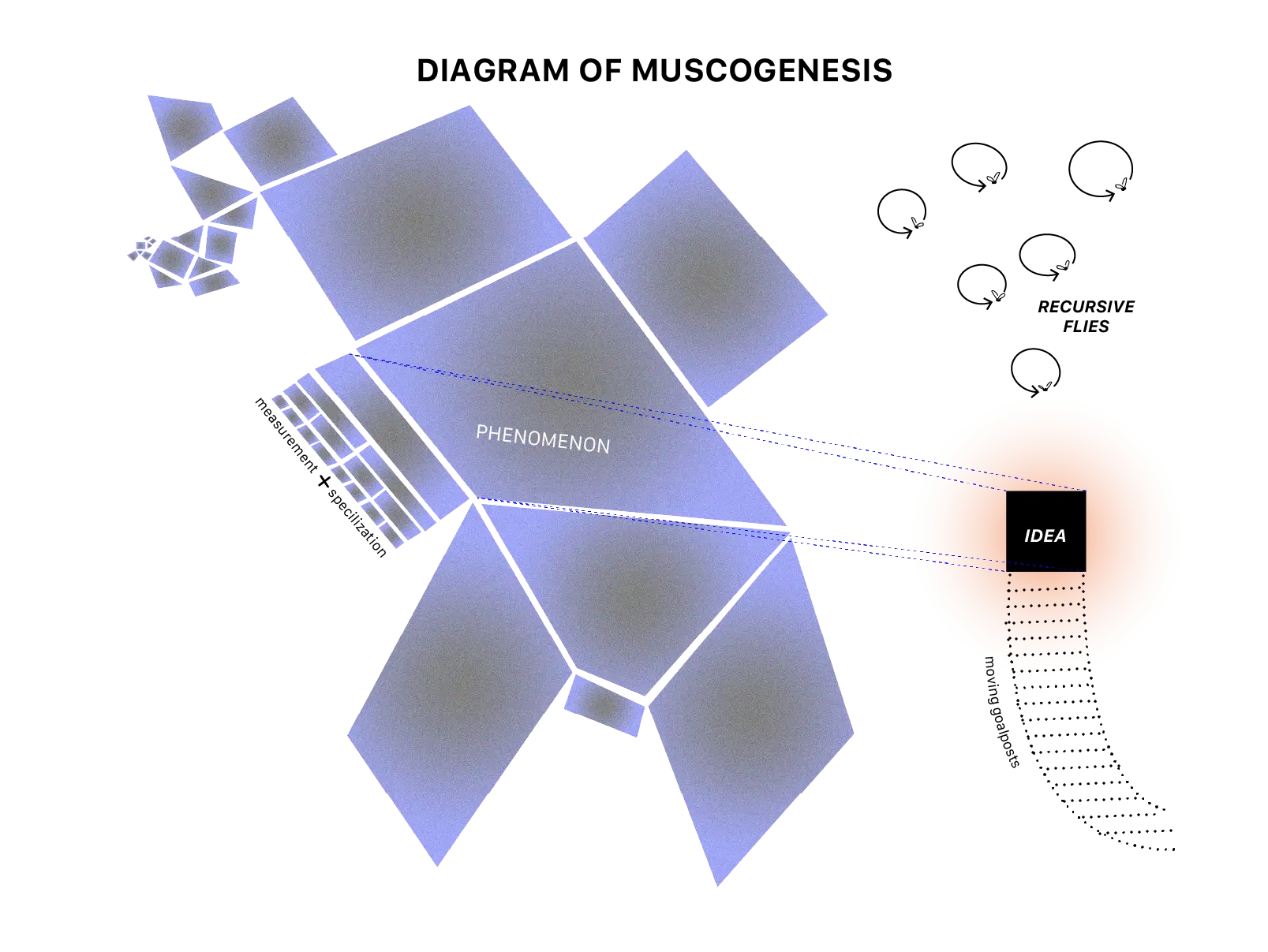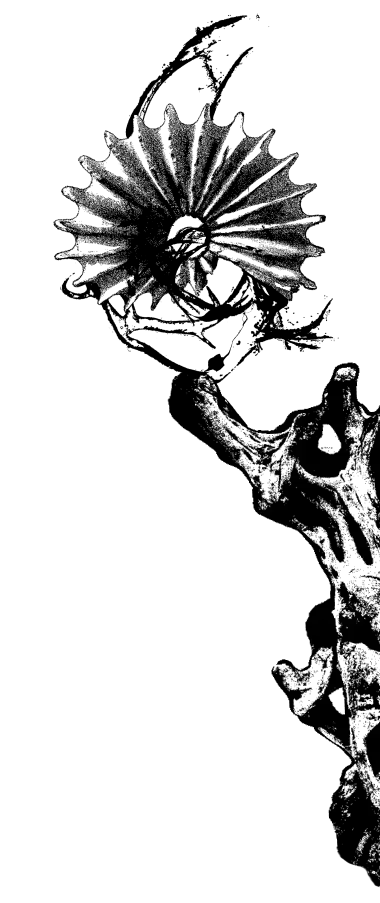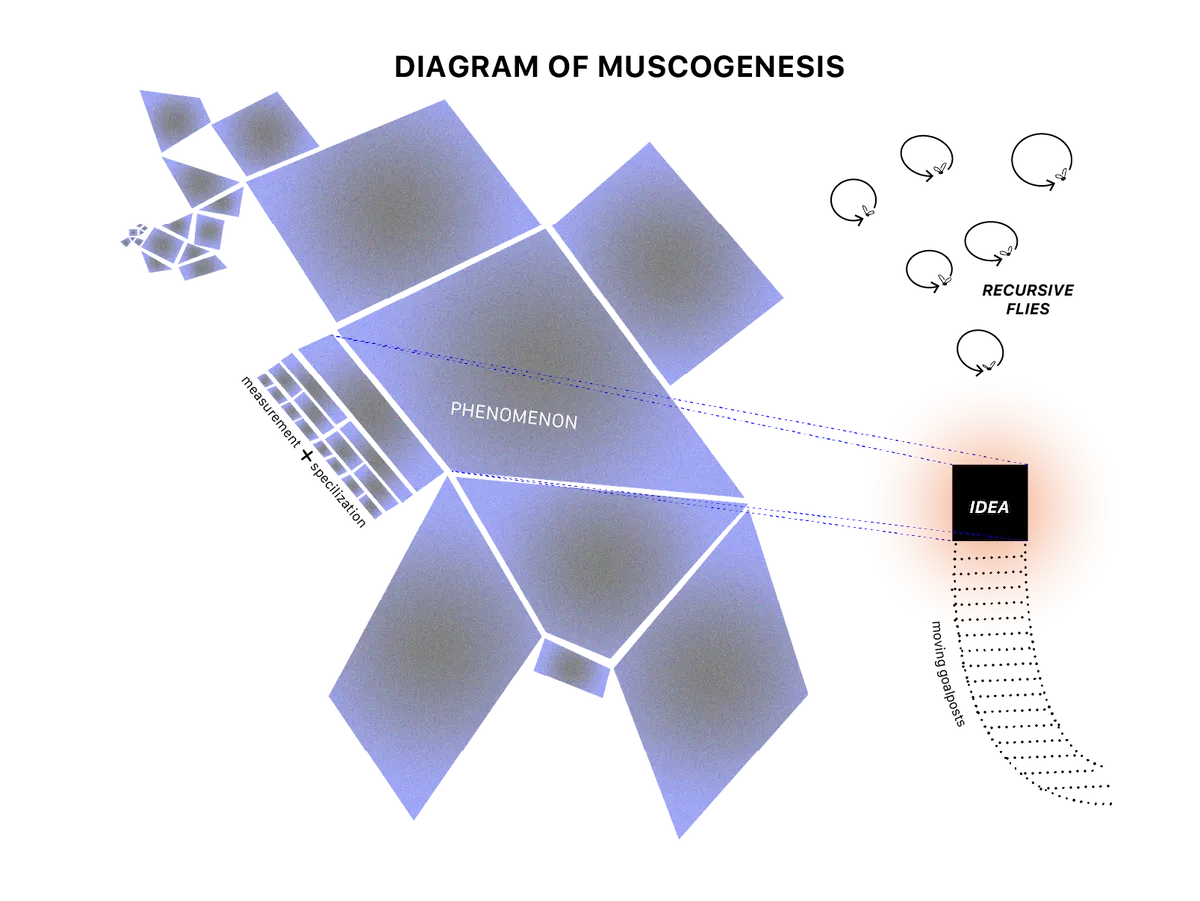This piece is a part of zine, which is a result of workshops led by Noise Research Union during Unsound 2024 in Krakow. I will link the entire zine once NRU put it up on their website https://n-r-u.xyz/
Have we finally been dragged out of the 20th century? It feels like the longer it continues, the less life is left to the ideas that once “worked,” unlocking the contexts they were constructed in, but now bouncing off the walls of falling institutions, like zombies. Neoliberalism turns into technofeudalism, post-fordism into vectorialism, postmodernism into post-truth. Each of these transitions shares a directionality of new norms: a system of new consistencies comes together, a system that has opened itself to noise many decades ago, and now seems to coagulate into a complex arrangement of (new) rules and procedures, which not only utilize noise for reproduction, but also determine how to control and modulate it. This dynamic planetary system of oppression as production (i.e., capitalism) moves one step ahead of anti-capitalist resistance that is still trapped in past images of its target of critique.
The fact that capitalist epistemology evolved to adopt noise into its functioning, or into its patterning, throws light on why so many contemporary resistance and revolutionary movements, especially when translated into the scale of national and international institutions and corporations, seem fragile and futile. On the micropolitical plane, the “left” keeps repeating mythologized actions based on the fetishization of noise as unpredictability and indeterminacy, and when these prove ineffective, it turns to even more dated tactics of unionizing the ghost of the worker movement, which again becomes picked apart by capitalist sociotechnics. On the macropolitical plane, the left gets trapped between neoliberal identity politics and neoconservative welfare chauvinism. The first plane reveals that it is not enough to invoke noise as disturbance, because the technological infrastructure, in particular the algorithmic architectures of social media platforms, capture, feed off of and dissipate noise within their framework. The second plane points to either the lack of vision that addresses the current and concrete fears and desires with a tangible better future, or the technical inability to assemble a political front out of diverse and discrete interests. There is nothing that could replace day-to-day political organization and aesthetic or libidinal experimentations, but both failures, of theoretical and activist practices, are tightly coupled with the problem of framing.
If we have moved from systems robust to noise (that could be mapped onto disciplinary societies) to systems resilient to noise (control societies), where “noise is not maximally suppressed, but functionally harnessed and modulated” (ref. previous zine), the question is: how to formulate a critique of such system as contemporary capitalism so that it isn’t an imaginary dissent, one which is futile or even counter-effective? When our notions of novelty are constituted by modernity, which locked the new with the disruptive, when capitalism drives the venture for novelty and invention, even when it comes to transforming its logic of functioning, it is very hard to think about the conditions needed for the new to “really” happen and hold. It is very hard to enframe the mainframing architecture (pun intended).
The problem with the new is that while we might strive for the new, we often inevitably and involuntarily fall back onto old patterns. In the desire for novelty lies the risk of setbacks that harden prevailing norms. An attempt to change mainframe patterning that heads towards (ecological, social, survival, etc.) catastrophe can become itself a catastrophic reaction that feeds back into an already (auto-)destructive framework. This framework could be understood as a form of control that moves phenomena out of control: Western foreign policies in the Middle East, green capitalism, neo-fascist state immigration systems, etc. If the capitalist system owes its resilience to computation technologies, feeding off of noise, the question is: how to conceptualize, transform and/or introduce new norms that aren’t plainly reinforcing capitalism? The insufficiency of “traditional” noise to disturb system flows, points to the task of reframing the constraints and noise generated by capitalist systems: both by post-capitalist metastable designs of noise and order (false) dichotomies. One approach to cognitive and collective practice for reframing and enframing problems and ideas involves the scheming of a certain semiotic device: a diagram.
As defined by Peirce1, a diagram is a type of an icon, a sign that “serves to convey ideas of the things they represent simply by imitating them”, which, by reducing the number of details (e.g., in geometrical figures) helps to gain knowledge of the represented thing. By perceiving abstracted and mapped relations between elements of a diagram we can discover new meanings embedded in the representation that were inaccessible before the act of drawing and exceed initial knowledge. For Peirce, a diagram was an imitation of relations already existing in (social) practices, an instrument for controlling the process of reasoning and achieving truth. Deleuze and Guattari2 expanded on that notion: a diagram should be de-iconized, separated from imitation, and understood as a tool for drawing new (social) relations based on what lies beyond representation; a vehicle for the exploration of virtual, unrepresented phenomena and possibilities beyond accepted truths. Such diagrams can be applied to relations between various layers of organisation (political, biological, libidinal, etc.) in order to point to something which is not itself. A diagram is for/about something else, it is a method to think of something else, something outside of already known (socially determined, etc.) relations between possibly existing things. A diagram points to the virtual, or in other terms, to the attentionally possibilistic3.
From this perspective, the diagrammatic method, especially collectively performed in a workshop context, is a method of addressing the problem of novelty and risk within specific margins of order and experimentation. When drawing a diagram we follow the constraints that compose the problem we are trying to articulate. In doing so—i.e., in “repeating” the present—we articulate new constraints that reposition the original set of constraints; it is an act of meta-mapping the present. This constraint, which is the diagram itself, can be understood in terms of Canguilhem’s4 normativity itself as being a source of new norms (against the normativity as the effect of a norm). A diagram reintroduces/enforces strict but possibilistic normativity: a space for renegotiating or contesting existing norms, and as associated with concepts and gestures, effectuated by the diagrammatic method. As such, diagram is a tool for determining and reframing noise as understood in different systems. It is a machine for moving, even if only ideally and formally, a set of constraints into a new metastable dynamic that can pattern noise in according to different logics.
As Sonia de Jager’s research explores, all patterning rests, ultimately, on the basic possibility-quality of symmetry: from paths of least action, to the morphologies of organisms, to the dynamics of imitation games5. Predictive capitalist patterning and its associated catastrophes (ecological destruction, social exploitation, war, etc.) can, at their most abstract, therefore also relate to the question of symmetry. Symmetry always contains a “double bind” (Bateson6), a twofold, one-two, left-right, 0s & 1s, who says a must say b, a=a, etc. All these are not “symmetrical” in a non-transformative way, but they are sustained by the idea of non-transformation5. We can therefore also relate reflection, recursion, repetition, replication, identity, unity and sameness, to a common symmetric denominator (ibid.). But what is equally inherent to symmetry is that repeated multiple time, if there exists a perceptual instrument or agent to capture its progression, itself generates asymmetry, because the context of each iteration is changed both by the identity function itself and by the external processes or other agents. As shown in Gregory Chatin’s algorithmic information theory7, the same algorithm produces new data by simple iteration. What is between the two sides of symmetry is the medium, which is not a substance, but a set of constraints or mediations, which inevitably introduce noise. This noise-introducing process is more intuitively understood in biology, where examples belong to the analog, continuous and material, not digital, ideal and abstract. The survival of an organism requires that the organism is capable of reproduction in the future, or maintains coherence over time. Although reproduction means repetition of its own past pattern, for it to be effective, the organism needs to predict both external and internal environment’s behaviour, take it into account and project itself into the future. Asymmetry has crept into the symmetry-driven logic of the organism. To remain the same, you have to change (famous adage, recently oft-cited by Michael Levin). Or even further: time forces constant repetitions, and on the organism’s adaptability, its reason, cunning, techne, etc., depends how its pattern or form is going to be repeated.
That’s why, as this diagram indicates, Plato can be understood as a philosopher of noise, where the projection of ideas onto the phenomenal plane is noised or corrupted by the very fact that it is projected/perceived. The idea is an abstract blueprint generated by the passage of time; time is what introduces noise to the realization of an idea, but it is also intrinsic to the realization of the idea. It is unthinkable without time and without the noisy medium it unfolds/that unfolds it.
This question of symmetry is taken up by several time-travel and teleportation science fictions8. In David Cronenberg’s The Fly (1986), an eccentric scientist invents a machine that allows teleportation. While testing the telepod, he teleports himself unaware of a housefly inside the device, which initiates a mutation. At first, he seems normal, reiterated, copied 1:1, but as time passes the differences set off by the fly in the telepod begin to manifest, eventually resulting in a new lifeform. The new lifeform becomes a new frame of values as he exhibits increased strength, stamina, and sexual potency, which he attributes to the teleportation “purifying” his body. In our diagram, the joke was made about the fly (the insect, not the film) as performing an identity operation: the fly does not only reflect a figure of (annoyance) noise and time, but is also itself a metaphor for the identity operator: its flight pattern being one that tends to revolve around a point of recurrence (this is the “recursive flies” region of the diagram). In tying all these co-occurrences together, this is why we called it: The Diagram of Muscogenesis.

The “Measurement & specialization” zone of the diagram points to transcendental structures (access to ever-more refined technical analysis/capture, scientific analysis, (philosophical) concepts, etc.). When, e.g., a concept is construed, it symmetrically actuates/imprints itself in being or matter, it becomes a form of intuition, a framework of perception. When science cuts at reality, it too expresses itself and creates ever-more refined bifurcations. This is why we represented this structure in fractal-form. This can also be understood to refer to the heard/unheard diagram on the following page (which we also worked on together), since repetitive deployment of concepts can bring forth two types of noise: 1) one that is blocked and repressed, as is evident, e.g., in relation to media coverage of the ongoing genocide of Palestinians: their stories, suffering and death are systemically, by design, unheard; 2) the other is constituted by the concept. The concept, such as “a proton,” by determining and mediating certain phenomena, composes noise that requires further specification into different kinds of concepts (e.g., quarks), as well as technical means to access these and further refine both the concepts and the (technical, scientific) access. However, continued specification/spcialization in pursuit of understanding complexity can itself collapse into noise, because there is a finite amount of notions and relations that one can grasp phenomenologically and account for structurally and discursively (e.g., Wittgenstein, or, if you prefer: Lacan).
N.B.: this text, as an exception, was written primarily by Patrick Leftwich, and edited by the NRU. The diagram was constructed by de Jager, Leftwich and Michał Piech.
Footnotes
-
Peirce, C. S. (1933), Collected papers Volume IV, eds. Charles Hartshorne and Paul Weiss, Cambridge: Harvard University Press. ↩
-
Deleuze, G., and Félix Guattari, (1977), Capitalism and schizophrenia. Vol. 1, New York, Viking Press. ↩
-
Albarracin, de Jager and Hyland, (2025), The Physics and Metaphysics of Social Powers: Bridging Cognitive Processing and Social Dynamics, a New Perspective on Power Through Active Inference, Entropy 27, 522. https://doi.org/10.3390/e27050522 ↩
-
Canguilhem G., ((1904) 1950), The Normal and the Pathological (introduction by M. Foucault, tr. by Carolyn R. Fawcett in collaboration with Robert S. Cohen). ↩
-
de Jager, S. (2024), All Things Mirrored: A speculation into the effects of reflection(s), duplication and symmetry through active inference, Active Inference Institute. See also: “Negation” entry on n-o.ooo. ↩ ↩2
-
Bateson, G. (1963), A note on the double bind, Family process 2.1 (1963): 154-161. ↩
-
Chaitin, G. J. (1977), Algorithmic information theory, IBM journal of research and development 21.4: 350-359. ↩
-
See also: “THE PATTERN BUTCHER”, de Jager 2023. ↩


